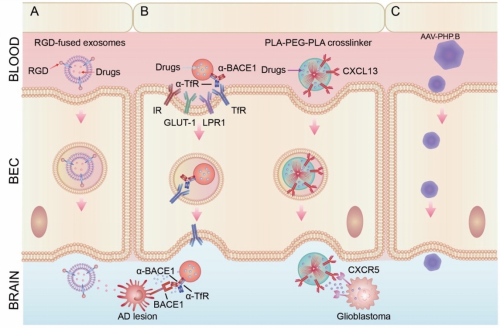Rencently, Prof. Jia Li’s research group published an invited review article titled Development of Novel Therapeutics Targeting the Blood–Brain Barrier: From Barrier to Carrier in Advanced Science (Impact Factor 15.8).

Figure 1. Employment of transcytosis for brain-targeted delivery
The blood–brain barrier (BBB) is a highly specialized neurovascular unit. It was initially described as an essential barrier to prevent toxins, pathogens, and potentially harmful substances from entering the brain, which is critical to protect the normal function of brain. However, the restrictive nature of BBB also place a formidable hurdle for drug delivery into the brain. Tremendous effects have been made to enhance BBB penetration of brain-targeted drugs in last decades. On the other hand, Recent restudies also indicate that the BBB is actively engaged in the crosstalk between neuronal and the circulatory systems. Indeed, impairment in BBB integrity and function play a critical role in the initiation and development of neurological disorders and cerebrovascular diseases. Therefore, this dual-role of BBB as both a barrier and carrier makes the BBB a unique therapeutic target.
This Review first summarized the core components of the BBB and the main factors involved in the regulation of BBB structural integrity and normal function. The strategies to promote these factors to maintain or restore the integrity of the BBB to treat related neurodegenerative diseases (Alzheimer's disease, Parkinson's disease, etc.) and cerebrovascular diseases (stroke, vascular cavernous malformations, etc.) were then summarized. Next, the author summarized the methods to open the BBB by inhibiting those factors from the opposite perspective. In particular, authors focused on the strategies, both in preclinical and clinical settings, to either inhibit tight junction proteins to directly disrupt BBB or employ physical methods (eg. focused ultrasound) and chemical methods (transient inflammation, angiogenic molecules, oxidation, cytoskeleton reorganization etc.) to open the BBB in an indirect matter. Further, authors summarized the strategies to develop nanoparticle-based delivery system to cross the BBB. Subsequently, authors took neuroinflammation as an example to demonstrate the strategies to treat neuroinflammation by restoring BBB integrity and harness transcytosis to deliver therapeutics into the brain parenchyma, highlighting the unique role of BBB as a therapeutic target in the treatment of brain diseases. Finally, this Review discussed the challenges and perspective in the development of brain-targeted therapeutic drugs by targeting the blood-brain barrier. This Review provides a timely and beneficial reference for the development of brain-targeted therapeutics.
Jia Li, a distinguish professor at School of Pharmacy, Henan University, is the first author of this article. Henan University is the first affiliation. Other researchers involved in this study are affiliated with institutions in China, Australia and the United States. This work was funded by the Outstanding Talent Special Zone Program of Henan University.
VIEW FULL TEXT: https://onlinelibrary.wiley.com/doi/10.1002/advs.202101090

